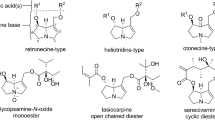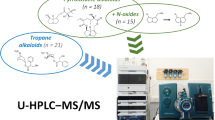Abstract
Pyrrolizidine alkaloids (PAs) are a large class of natural compounds amongst which the esterified 1,2-unsaturated necine base is toxic for humans and livestock. In the present study, a method was developed and validated for the screening and quantification of nine PAs and one PA N-oxide in teas (Camellia sinensis (L.) O. Kuntze) and herbal teas (camomile, fennel, linden, mint, rooibos, verbena). Samples were analysed by HPLC on a RP-column, packed with sub-2 μm core-shell particles, and quantified using tandem mass spectrometry operating in the positive electrospray ionisation mode. These PAs and some of their isomers were detected in a majority of the analysed beverages (50/70 samples). In 24 samples, PA concentrations were above the limit of quantification and the sum of the nine targeted PAs was between 0.021 and 0.954 μg per cup of tea. Thus, in some cases, total concentrations exceed the maximum daily intake recommended by the German Federal Institute for Risk Assessment and the UK’s Committee On Toxicity (i.e. 0.007 μg kg−1 bw).

ᅟ





Similar content being viewed by others
References
Codex Alimentarius Commission (2011) Discussion paper on pyrrolizidine alkaloids. CX/CF 11/5/14
Zhang F, Wang C-H, Xiong A-Z, Wang W, Yang L, Branford-White CJ, Wang Z-T, Bligh SWA (2007) Quantitative analysis of total retronecine esters-type pyrrolizidine alkaloids in plant by high performance liquid chromatography. Anal Chim Acta 605:94–101. doi:10.1016/j.aca.2007.10.021
Fu PP, Xia Q, Lin G, Chou MW (2004) Pyrrolizidine alkaloids: genotoxicity, metabolism enzymes, metabolic activation, and mechanisms. Drug Metab Rev 36:1–55. doi:10.1081/dmr-120028426
Bartkowski J-PB, Wiedenfeld H, Roeder E (1997) Quantitative photometric determination of senkirkine in Farfarae Folium. Phytochem Anal 8:1–4. doi:10.1002/(SICI)1099-1565(199701)8:1<1::AID-PCA328>3.0.CO;2-H
BfR (2013) Pyrrolizidine alkaloids in herbal teas and teas
Wiedenfeld H, Edgar J (2011) Toxicity of pyrrolizidine alkaloids to humans and ruminants. Phytochem Rev 10:137–151. doi:10.1007/s11101-010-9174-0
Li YH, Kan WLT, Li N, Lin G (2013) Assessment of pyrrolizidine alkaloid-induced toxicity in an in vitro screening model. J Ethnopharmacol 150:560–567. doi:10.1016/j.jep.2013.09.010
Bach N, Thung SN, Schaffner F (1989) Comfrey herb tea-induced hepatic veno-occlusive disease. Am J Med 87:97–99
Gyorik S, Stricker H (2009) Severe pulmonary hypertension possibly due to pyrrolizidine alkaloids in polyphytotherapy. Swiss Med Wkly 139:210–211
Kumana CR, Ng M, Lin HJ, Ko W, Wu PC, Todd D (1985) Herbal tea induced hepatic veno-occlusive disease: quantification of toxic alkaloid exposure in adults. Gut 26:101–104
McGee J, Patrick RS, Wood CB, Blumgart LH (1976) A case of veno-occlusive disease of the liver in Britain associated with herbal tea consumption. J Clin Pathol 29:788–794
Ridker PN, McDermont WV (1989) Hepatotoxicity due to comfrey herb tea. Am J Med 87:701
Roulet M, Laurini R, Rivier L, Calame A (1988) Hepatic veno-occlusive disease in newborn infant of a woman drinking herbal tea. J Pediatr 112:433–436
Spang R (1989) Toxicity of tea containing pyrrolizidine alkaloids. J Pediatr 115:1025
Sperl W, Stuppner H, Gassner I, Judmaier W, Dietze O, Vogel W (1995) Reversible hepatic veno-occlusive disease in an infant after consumption of pyrrolizidine-containing herbal tea. Eur J Pediatr 154:112–116
Conseil de l’Institut suisse des produits thérapeutiques (2006) Ordinance on complementary and herbal medicinal products
Committee on toxicity of chemicals in food consumer products and the environment (2008) Statement on pyrrolizidine alkaloids in food
Boppre M, Colegate SM, Edgar JA, Fischer OW (2008) Hepatotoxic pyrrolizidine alkaloids in pollen and drying-related implications for commercial processing of bee pollen. J Agric Food Chem 56:5662–5672. doi:10.1021/jf800568u
Coulombe Jr RA (2003) Pyrrolizidine alkaloids in foods. In: Advances in food and nutrition research, 45. Academic, 61–99. doi:http://dx.doi.org/10.1016/S1043-4526(03)45003-1
Deinzer ML, Arbogast BL, Buhler DR, Cheeke PR (1982) Gas chromatographic determination of pyrrolizidine alkaloids in goat’s milk. Anal Chem (Washington, DC, U S) 54:1811–1814. doi:10.1021/ac00248a035
Edgar JA, Roeder E, Molyneux RJ (2002) Honey from plants containing pyrrolizidine alkaloids: a potential threat to health. J Agric Food Chem 50:2719–2730. doi:10.1021/jf0114482
Kempf M, Reinhard A, Beuerle T (2010) Pyrrolizidine alkaloids (PAs) in honey and pollen-legal regulation of PA levels in food and animal feed required. Mol Nutr Food Res 54:158–168. doi:10.1002/mnfr.200900529
Bosi CF, Rosa DW, Grougnet R, Lemonakis N, Halabalaki M, Skaltsounis AL, Biavatti MW (2013) Pyrrolizidine alkaloids in medicinal tea of Ageratum conyzoides. Rev Bras Farmacogn 23:425–432. doi:10.1590/S0102-695X2013005000028
Cao Y, Colegate SM, Edgar JA (2013) Persistence of echimidine, a hepatotoxic pyrrolizidine alkaloid, from honey into mead. J Food Compos Anal 29:106–109. doi:10.1016/j.jfca.2012.11.005
Cramer L, Schiebel H-M, Ernst L, Beuerle T (2013) Pyrrolizidine alkaloids in the food chain: development, validation, and application of a new HPLC-ESI-MS/MS sum parameter method. J Agric Food Chem. doi:10.1021/jf403647u
Griffin CT, Danaher M, Elliott CT, Kennedy DG, Furey A (2013) Detection of pyrrolizidine alkaloids in commercial honey using liquid chromatography-ion trap mass spectrometry. Food Chem 136:1577–1583. doi:10.1016/j.foodchem.2012.02.112
Griffin CT, Gosetto F, Danaher M, Sabatini S, Furey A (2014) Investigation of targeted pyrrolizidine alkaloids in traditional Chinese medicines and selected herbal teas sourced in Ireland using LC-ESI-MS/MS. Food Addit Contam Part A 31:940–961. doi:10.1080/19440049.2014.900193
Koleva II, van Beek TA, Soffers AEMF, Dusemund B, Rietjens IMCM (2012) Alkaloids in the human food chain—natural occurrence and possible adverse effects. Mol Nutr Food Res 56:30–52. doi:10.1002/mnfr.201100165
Tang J, Cheng M, Hattori M (2012) Pyrrolizidine alkaloid profile in a traditional Chinese herbal medicine Chuan Zi Wan (Ligulariae Radix et Rhizoma) by liquid chromatography/electrospray ionization ion trap mass spectrometry. Anal Methods 4:2797–2808. doi:10.1039/c2ay25300c
EFSA Panel on Contaminants in the Food Chain (CONTAM) (2011) Scientific opinion on pyrrolizidine alkaloids in food and feed. EFSA J 9:2406
Crews C (2013) Methods for analysis of pyrrolizidine alkaloids. In: Mérillon J-M, Ramawat KG (eds) Natural products. Springer, Berlin, pp 1049–1068. doi:10.1007/978-3-642-22144-6_186
Guillarme D, Nguyen DTT, Rudaz S, Veuthey J-L (2008) Method transfer for fast liquid chromatography in pharmaceutical analysis: application to short columns packed with small particle. Part II: Gradient experiments. Eur J Pharm Biopharm 68:430–440. doi:http://dx.doi.org/10.1016/j.ejpb.2007.06.018
Kumar P, Rubies A, Centrich F, Granados M, Cortes-Francisco N, Caixach J, Companyo R (2013) Targeted analysis with benchtop quadrupole-orbitrap hybrid mass spectrometer: application to determination of synthetic hormones in animal urine. Anal Chim Acta 780:65–73. doi:10.1016/j.aca.2013.04.017
Mroczek T, Ndjoko-Ioset K, Glowniak K, Mietkiewicz-Capala A, Hostettmann K (2006) Investigation of Symphytum cordatum alkaloids by liquid-liquid partitioning, thin-layer chromatography and liquid chromatography-ion-trap mass spectrometry. Anal Chim Acta 566:157–166. doi:10.1016/j.aca.2006.03.016
Bieri S, Varesio E, Muñoz O, Veuthey J-L, Christen P (2006) Use of porous graphitic carbon column for the separation of natural isomeric tropane alkaloids by capillary LC and mass spectrometry. J Pharm Biomed Anal 40:545–551. doi:http://dx.doi.org/10.1016/j.jpba.2005.07.007
Hubert P, Nguyen-Huu JJ, Boulanger B, Chapuzet E, Chiap P, Cohen N, Compagnon PA, Dewé W, Feinberg M, Lallier M, Laurentie M, Mercier N, Muzard G, Nivet C, Valat L, Rozet E (2007) Harmonization of strategies for the validation of quantitative analytical procedures: a SFSTP proposal—part II. J Pharm Biomed Anal 45:70–81. doi:10.1016/j.jpba.2007.06.013
EFSA (2005) Opinion of the scientific committee on a request from EFSA related to a harmonised approach for risk assessment of substances which are both genotoxic and carcinogenic. EFSA J 282:1–31
Social science statistics. http://www.socscistatistics.com/Default.aspx
Dubecke A, Beckh G, Lullmann C (2011) Pyrrolizidine alkaloids in honey and bee pollen. Food Addit Contam Part A 28:348–358. doi:10.1080/19440049.2010.541594
European Herbal Infusions Association (2014) Compendium of Guidelines for Herbal and Fruit Infusions. 5
Acknowledgments
Dr Pierre-Marie Allard and Dr Florence Mehl (School of Pharmaceutical Sciences, EPGL, Switzerland) are gratefully acknowledged for their assistance with Quadrupole-Orbitrap data acquisition and statistical analysis, respectively.
Author information
Authors and Affiliations
Corresponding author
Rights and permissions
About this article
Cite this article
Mathon, C., Edder, P., Bieri, S. et al. Survey of pyrrolizidine alkaloids in teas and herbal teas on the Swiss market using HPLC-MS/MS. Anal Bioanal Chem 406, 7345–7354 (2014). https://doi.org/10.1007/s00216-014-8142-8
Received:
Revised:
Accepted:
Published:
Issue Date:
DOI: https://doi.org/10.1007/s00216-014-8142-8




